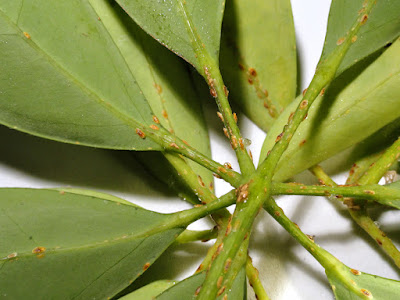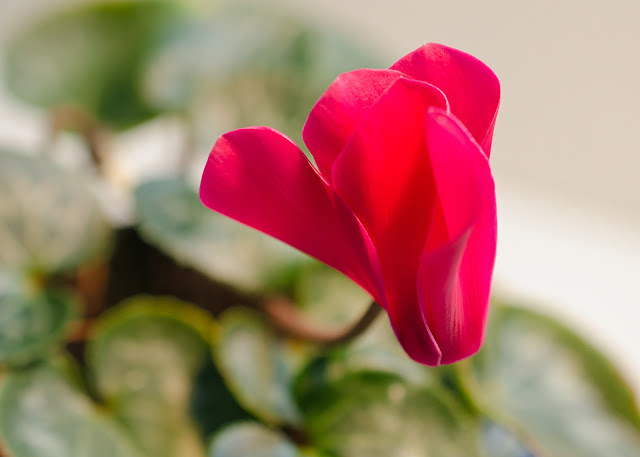The leaves were falling off my
Schefflera houseplant. Just a few, at first; I picked them up and thought nothing of it. Then, last week, there were more every day. Saturday, I finally got around to really looking at the plant, and discovered that it was covered with scale insects and their excretions.
 |
| A plague on all their houses! |
 |
| A closer view. Scales, sticky sap, bubbles of honeydew. |
These are
soft scale insects, Coccidae, feeding on the plant juices, gradually killing their host. They don't look like insects; all that's visible is a shell glued to the stem or veins of the plant, like a limpet to a rock. But the limpet wanders about; these do not.
They are probably all females; some species reproduce by parthenogenesis, without the need for a male. In other species, the males live for only a short time; they do not feed.
Female scale insects attach themselves to a handy location, and settle down to eat and lay eggs, 1000 or more in a season. They cover themselves and their eggs with a thin coat of wax and feces. As they feed, they excrete excess liquid through pores in various places; this is a sweet, sticky substance, called "honeydew". It covers the leaves and stems, attracting fungus spores and, on houseplants, dust.
 |
| Little bird from Chinatown apologizes for not eating the bugs. |
I broke off the stems and leaves where the scale insects were thickest. Some of the scales fell off, so I collected them to get a better look at them.
 |
| Side view, showing the waxy cap, and the mass of eggs or young underneath. |
When the female dies, her eggs remain protected underneath her dead body until they are ready to hatch.
 |
| The largest scale I found, just over 3 mm. (1/8 inch) long. She was dead, her babies long gone. |
 |
| Several sizes and conditions. Upper left, on top of the pile, what looks like white wax emerges from a central rear pore. Extreme right, center, a dead, empty shell, upside-down. |
Most of the scales that had fallen off seemed to be dead and empty, but as I examined them, one started to rock. Then a very tiny, almost transparent baby crawled out from underneath. As I watched, others joined her.
 |
| Medium -sized nymph, about 1.5 mm. long. |
 |
| The tiniest crawler, half a millimeter long. If you look very closely you can see a hint of legs. She could move at a pretty good pace for her size. |
I don't know if those two black spots in front are eyes. Someone
asked about that on BugGuide, but got no answer.
Only the newly-hatched insects crawl about; once they've found a good feeding spot, they settle down. In some species, they lose their legs entirely.
And now it was time to rescue my poor plant. The leaves I had removed went into the garbage, sealed in a plastic bag. I put the Schefflera in the shower and hosed it down thoroughly with lukewarm water and lots of soap. I took off the top layer of soil and scrubbed the pot, too. When it dried, I checked it over and discovered a couple dozen more scales; these I squashed.
Tonight, the plant looked healthy, but I found another few small scales along the veins of leaves, and removed them. I will have to continue monitoring until I know all the nymphs are gone.
There's an excellent photo of one of these, by
Scott Justis, on Flickr, here's
Wikipedia on the scale insects, and the
USDA Systematic Entomology Laboratory, has a good discussion of the Coccid family.

















